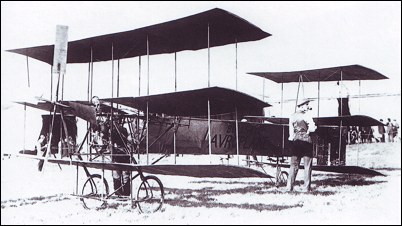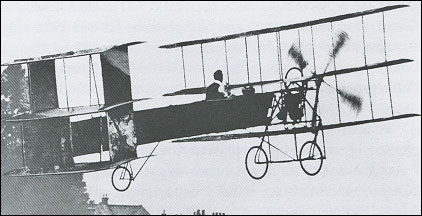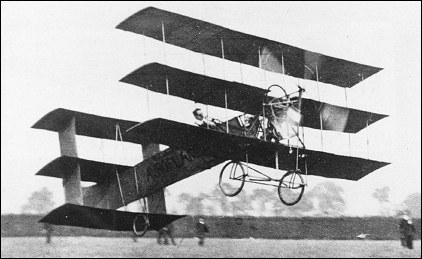|
| Alliot Verdon Roe, the founder of Avro, the firm that was to play such a huge part in the development of aviation, embarked on his career
as an aircraft designer in 1907 with a canard pusher biplane design, the Roe No 1. He entered the aircraft in the contest to be the first pilot to fly round the Brooklands racing circuit, which carried a GBP2500 prize, but was unsuccessful.
Undeterred, he embarked on the design of a triplane and on 23 July 1909, with Roe at the controls, the resulting Triplane No 1 became the first British aircraft powered by a British-designed engine to
make a successful flight in England. A second aircraft, the Roe II Triplane, flew successfully at Brooklands. These early designs provided invaluable experience when it came to the development of A.V. Roe's first true success, the celebrated Avro 504.
| CREW | 1 |
| ENGINE | 1 x 9hp JAP 2-cylinder Vee-type engine |
| WEIGHTS |
| Take-off weight | 204 kg | 450 lb |
| DIMENSIONS |
| Wingspan | 6.10 m | 20 ft 0 in |
| Length | 7.01 m | 23 ft 0 in |
| Height | 3.35 m | 11 ft 0 in |
| PERFORMANCE |
| Max. speed | 40 km/h | 25 mph |
| Lynn Morton, e-mail, 28.12.2024 15:12 Looking at enlarged versions of the photographs, this plane doesn't appear to have any control surfaces reply | | Terrence I. Murphy, e-mail, 08.02.2012 19:17 The Roe I Triplane (often later referred to as the Avro Triplane) was an early aircraft, the first all-British aircraft to fly (Roe's previous biplane had a French engine). It featured not only a triplane wing, but a triplane tail as well. It was of extremely flimsy construction; financial hardship compelled Roe to use wood for structural elements where he would have preferred steel, and the wings and fuselage were paper-covered. Roe nicknamed the aircraft The Blues after the braces manufactured by his brother's firm that had helped pay for it. Beginning on 5 June 1909, he made a series of short hops on the Walthamstow Marshes (then in Essex, but now within the London Borough of Waltham Forest). The triplane's wings were damaged by crashes during these attempts, but Roe persevered.
On 13 July, he achieved a flight of 100 ft (30 m), and ten days later, one of 900 ft (280 m). With confidence building, he swapped the original 6 hp (5 kW) JAP motorcycle engine for a 24 hp (18 kW) Antoinette. With this engine, he piloted the aircraft on several short flights at the Blackpool Meeting in October before it was damaged beyond repair in a crash.
General characteristics
• Crew: one pilot
• Length: 23 ft 0 in (7 m)
• Wingspan: 20 ft 0 in (6 m)
• Wing area: 285 ft2 (26.5 m2)
• Empty weight: 300 lb (140 kg)
• Gross weight: 450 lb (200 kg)
• Powerplant: 1 × JAP, 20 hp (15 kW) each
Performance
• Maximum speed: 25 mph (40 km /h)
• Range: ⅓ miles (0.5 km) reply |
|
Do you have any comments?
|
| 
COMPANY
PROFILE
All the World's Rotorcraft
|








